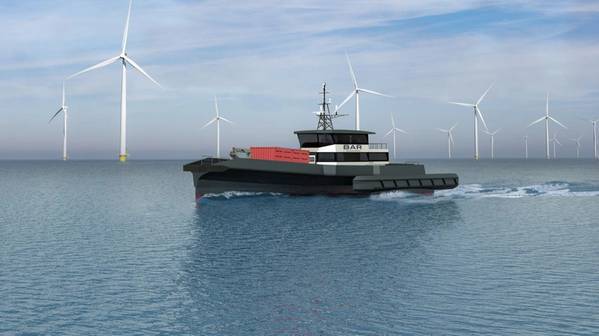
Vessel designer Chartwell Marine has partnered up with naval architects BAR Technologies, to support in the delivery of what it says will be the next generation of offshore wind crew transfer vessels (CTVs).
"The partnership will drive forward the development of new vessel designs ranging from 30m CTVs through to 60m service accommodation and transfer vessels (SATVs), making use of BAR’s patented foil optimization and stabilization system (FOSS)," Chartwell Marine said Wednesday.The partnership will combine Chartwell’s structural, class, and engineering design joined with BAR’s innovations in hydrofoil technology and hull form development expertise.
According to Chartwell, the offshore energy support vessel market is well served by the likes of existing designs, however, trend for building further out at sea presents new challenges in the form of longer journeys and rougher waters. These challenges are further compounded by the drive to reduce operating costs, and carbon emissions, by cutting fuel consumption.
"This has led to an industry demand for larger vessels that are not only designed specifically for bulk crew transfers and longer distance voyages, but also demonstrate greater efficiency and lower fuel burn, leading to significant savings for operators as well as a reduced carbon footprint. Further, the industry is pushing for vessels with the capability to operate for longer periods – to the extent of crew and technicians sleeping on board, requiring an advanced hull," Chartwell Marine said.
"Responding to this trend in CTV procurement, BAR – with the support of Chartwell – have created a 30m vessel which can reduce vertical acceleration by up to 70% in 2.5m wave heights, helping with motion sickness and offering greater levels of availability in rougher seas. BAR’s FOSS technology, which helps to dampen pitch and roll, will also be an option available on new Chartwell vessels, and can be offered and applied to the Chartwell 24 vessel – further enhancing its seakeeping capability and renowned maneuverability," the company said.
Andy Page, Managing Director, Chartwell Marine, said: "As offshore wind expands globally, the challenges of constructing and maintaining wind farms in a variety of locales require forward-thinking CTV operators to make use of the full range of vessel sizes available to the market."
"With industry demand coalescing around larger vessels, there is a clear opportunity to deploy the latest technology and knowledge from other maritime sectors to deliver a new range of 30m+ CTVs which satisfy the growing requirements of offshore wind while, crucially, meeting the latest needs in efficiency."
John Cooper, CEO, BAR Technologies, said: "We see the Chartwell 24 and BAR 30m vessels as natural partners. The former provides high versatility, high payload and large deck space, while the latter demonstrates up to 50% fuel efficiency savings at 15 knots and advanced seakeeping at speed, which is particularly noticeable on longer journeys – as well as great static seakeeping attributes.
"Chartwell’s strong engineering capability and design heritage has allowed us to create an advanced superior solution for owner-operators based on their varied project requirements."